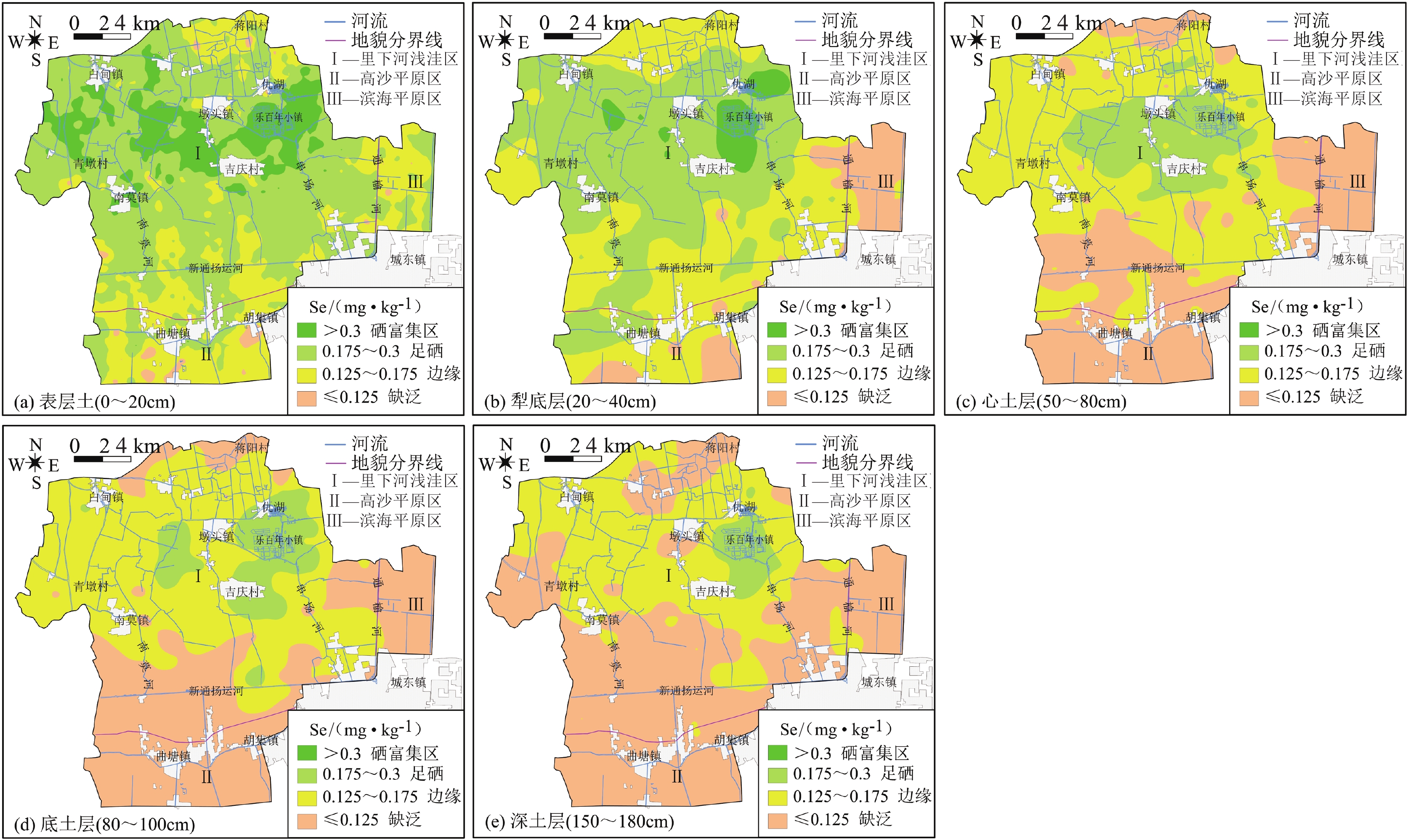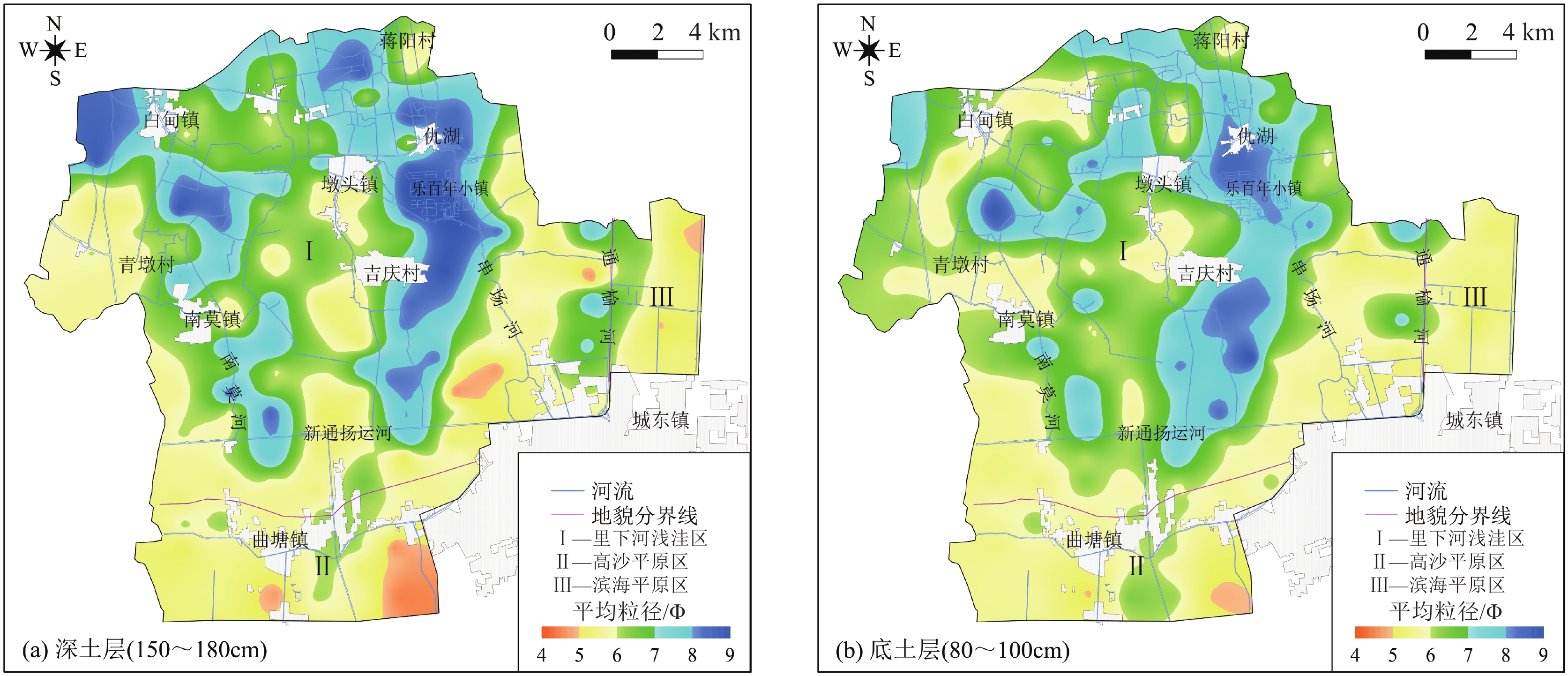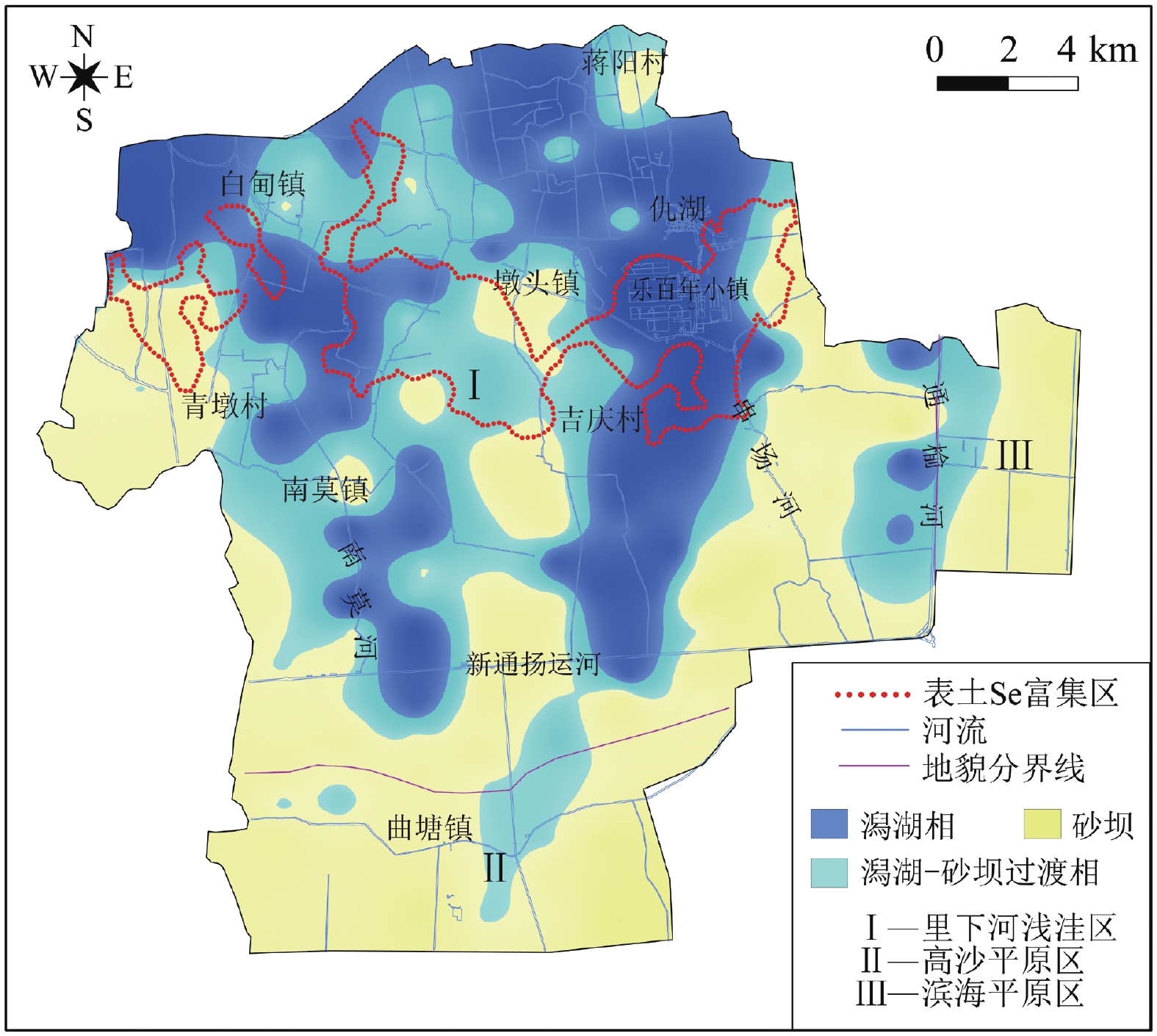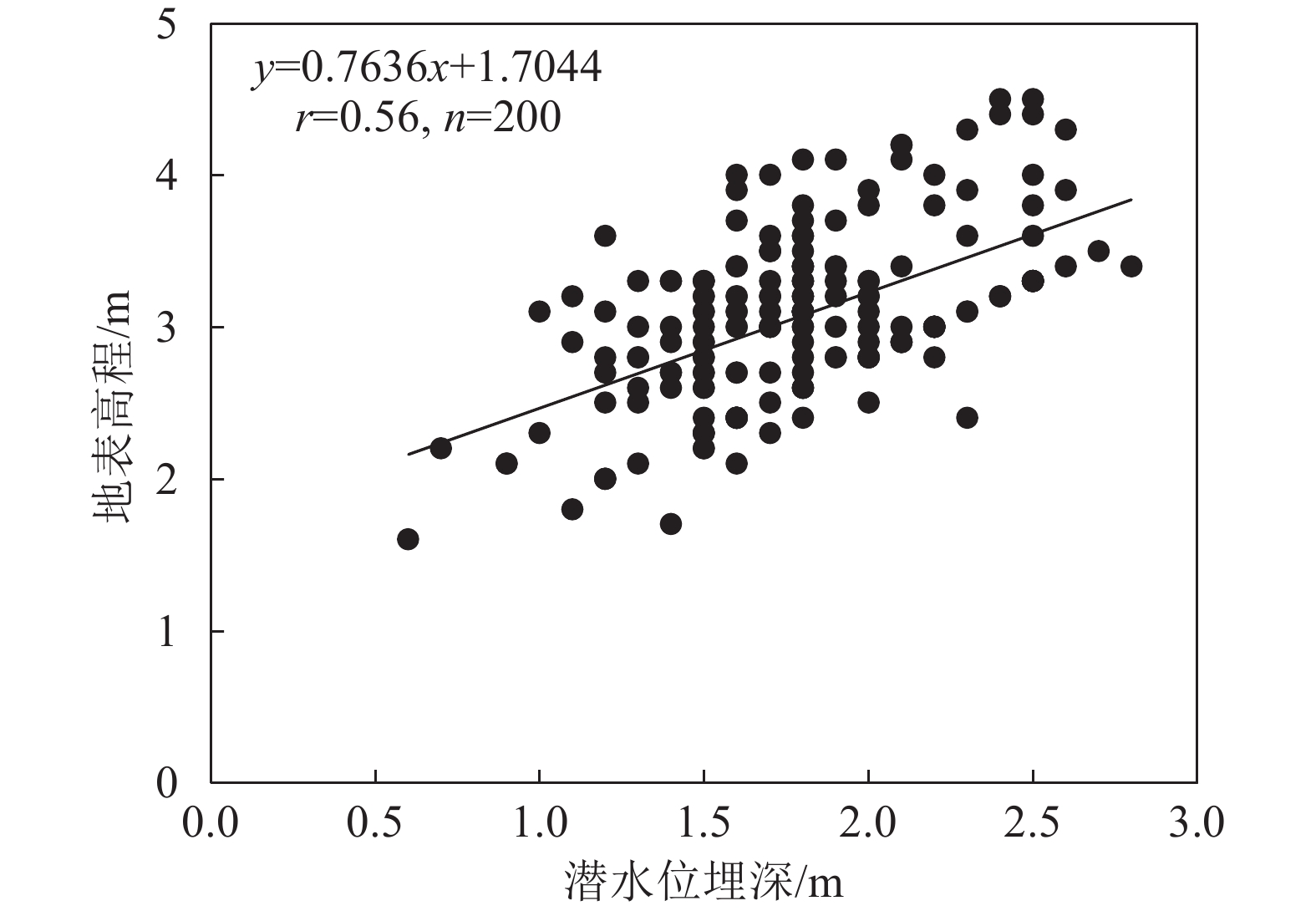Distribution and causes of selenium-rich soil in Lixiahe area of Hai 'an, Jiangsu Province
-
摘要:研究目的
近年来,天然富硒土地资源的开发利用越来越受到关注,但对于远离母岩的平原区富硒土壤成因尚不明确。以海安里下河地区为例,探讨平原区富硒土壤分布特征及其成因,进而指导富硒土地资源的开发利用。
研究方法系统梳理了研究区1800组表层土壤样品和1000组土壤剖面样品地球化学数据,并给合以往研究资料,对数据开展了综合分析研究,采用沉积物的粒度特征反演了母质沉积环境。
研究结果研究区农用地表层土壤中Se含量最高达0.63 mg/kg,富集区(≥ 0.3 mg/kg)面积达66 km2。土壤垂向剖面上,耕作层(0~20 cm)、犁底层(20~40 cm)、心土层(50~80 cm)、底土层(80~100 cm)和深土层(150~180 cm)Se平均含量分别为0.23 mg/kg、0.18 mg/kg、0.13 mg/kg、0.12 mg/kg、0.11 mg/kg,表聚性十分明显;表层土壤Se含量与母质层呈高度正相关,其相关系数在0.6~0.8(p<0.01)之间。地表高程与土壤Se含量出现极显著负相关,相关系数达−0.6 (p<0.01),地势越高,土壤Se含量越低;土壤有机质与Se呈显著的正相关,成壤过程对硒具有重要的吸附和固定作用。
结论研究区母质层主要受古潟湖-砂坝沉积体系的控制,富硒土壤主要为发育于古潟湖相的母质经表生富集作用形成,潟湖相沉积环境控制了土壤硒富集边界。基于多元线性回归分析技术揭示了土壤硒富集控制因素,其中土壤有机质对于研究区Se的富集起到了决定性作用,对土壤硒富集的贡献率达70%。
Abstract:ObjectiveRecently, the development and utilization of natural selenium−rich land resources have attracted increasing attention. However, the genesis of selenium−rich soil in plain areas far from parent rocks is still unclear. This paper aims to take the Lixiahe area in Hai'an as an example to explore the distribution characteristics and genesis of selenium−rich soil in plain areas, thereby guiding the development and utilization of selenium−rich land resources.
MethodsThe paper systematically collated geochemical data from 1800 groups of surface soil samples and 1000 groups of soil profile samples in the study area, and combined with previous research data, conducted a comprehensive analysis and study of the data. The grain size characteristics of sediments were used to infer the depositional environment of the parent material.
ResultsThe selenium (Se) content in the surface soil of agricultural land in the study area reaches up to 0.63 mg/kg, and the area of the enrichment zone (≥ 0.3 mg/kg) is 66 km2. In the vertical soil profile, the average Se content in plough layer ( 0~20 cm ), plough pan ( 20~40 cm ), subsoil ( 50~80 cm ), subsoil ( 80~100 cm ) and deep soil ( 150~180 cm ) were 0.23 mg/kg, 0.18 mg/kg, 0.13 mg/kg, 0.12 mg/kg, and 0.11 mg/kg, respectively, showing a very obvious surface accumulation; the selenium content in surface soil was highly positively correlated with the parent material layer, with a correlation coefficient between 0.6 and 0.8 (P<0.01). There was a highly significant negative correlation between ground elevation and soil Se content, with a correlation coefficient of −0.6 (P<0.01), indicating that the higher the terrain, the lower the soil Se content; soil organic matter (SOM) was significantly positively correlated with Se, playing an important role in the adsorption and fixation of selenium during soil formation.
ConclusionsThe parent material layer was mainly controlled by the ancient lagoon−sand dam sedimentary system. The selenium−rich soil in the area was mainly formed by the supergene enrichment of the parent material developed in the ancient lagoon facies. The lagoon facies sedimentary environment controls the selenium enrichment boundary of the soil. Based on multiple linear regression analysis, the controlling factors of soil selenium enrichment were revealed. Among them, SOM played a decisive role in the enrichment of Se in this area, and the contribution rate to soil Se enrichment was 70%.
-
Keywords:
- selenium-rich soil /
- soil organic matter (SOM) /
- lagoon /
- Lixia river /
- genesis /
- Hai 'an, Jiangsu Province
创新点里下河古潟湖边缘与苏北平原相比土壤硒含量更富集,成壤过程中有机质对硒具有重要的吸附和固定作用,有机质是平原区富硒土地评价的重要指标,有助于评价土壤硒是否有稳定来源。
-
-
表 1 土壤样品测试方法
Table 1 Test method of soil sample
测试指标 样品粒度 测试方法 检出限 RE RD 参照标准 pH ≤2 mm ISE 0.1 0.7~7.9% 1.6~15.8% 《土壤中pH的测定》
(NY/T 1377—2007)粒度分析 ≤2 mm 激光衍射法 0.01% 0.6~15% 2.1~19.5% 《粒度分布 激光衍射法》
(GB/T 19077—2016)有机质(SOM) ≤0.149 mm 重铬酸钾法 0.20‰ 0~4.1% 0.1~10% 《土壤检测 第6部分:土壤有机质的测定》(NY/T 1121.6—2006) 全Se ≤0.149 mm 原子荧光光谱法 0.01
mg/kg0.2~4.8% 3.0~12.8% 《土壤中全硒的测定》
(NY/T1104—2006)表 2 土壤Se及主要理化指标特征统计结果
Table 2 Characteristics of soil selenium and its main physicochemical indicators
土壤层位 耕作层(0~20 cm) 犁底层(20~40 cm) 心土层(50~80 cm) 底土层(80~100 cm) 深土层(150~180 cm) 样本数 n=1800 n=200 n=200 n=200 n=200 Se/(mg·kg−1) 范围 0.07~0.63 0.05~0.37 0.04~0.32 0.04~0.28 0.05~0.23 均值 0.23 0.18 0.13 0.12 0.11 SOM/‰ 范围 6.2~64.5 3.6~28.4 3.2~23.1 1.3~25.2 0.3~25.4 均值 26.9 13.2 8.7 6.7 6.5 pH 范围 4.90~8.48 6.80~8.50 6.89~8.74 7.19~9.07 7.11~9.25 中值 7.24 7.89 8.01 8.23 8.41 平均粒径/Ф 范围 4.97~8.04 5.00~8.71 4.67~8.72 4.91~9.05 4.49~9.23 均值 5.91 6.18 6.27 6.43 6.47 表 3 土壤Se分级标准
Table 3 Soil selenium classification standard
指标 缺乏 边缘 足硒 富集区 过剩 Se/(mg·kg−1) ≤0.125 0.125~0.175 0.175~0.3 0.3~3 >3 表 4 研究区各沉积单元粒度参数特征
Table 4 Characteristics of particle size parameters of each sedimentary unit in the study area
地貌分区 沉积单元 参数 平均粒径/Ф 粘粒/% 粉粒/% 砂粒/% SOM/‰ Se/(mg·kg−1) 里下河
浅洼区潟湖 范围 6.88~9.23 20~51.5 30~51.29 9.28~39.13 1.26~25.36 0.06~0.23 平均值 8.14 34.5 44.04 21.45 10.08 0.14 砂坝 范围 4.56~7.36 0.34~4.22 17.5~79.05 18.29~82.17 1.2~16.76 0.05~0.16 平均值 5.84 2.14 50.89 46.94 5.79 0.1 高沙平原 砂坝 范围 4.49~6.53 0.42~3.48 15.87~71.55 24.97~83.71 1.26~10.36 0.04~0.11 平均值 5.61 1.83 45.66 52.48 3.11 0.06 滨海平原 砂坝 范围 4.93~6.32 0.6~3.16 28.44~64.57 32.27~70.96 1.2~7.26 0.04~0.11 平均值 5.48 1.34 41.59 57.07 3.07 0.06 表 5 表层土壤Se含量与下部各土壤Se含量相关系数(n=200)
Table 5 Relationship between Se content in surface soil and Se content in lower soil
土层/cm 犁底层(20~40) 心土层(50~80) 底土层(80~100) 深土层(150~180) 表层(0~20) 0.79** 0.71** 0.65** 0.60** 注:**表示在0.01水平(双侧)上显著相关 表 6 地表高程与各层位Se、SOM、粘粒、Mz相关系数(n=200)
Table 6 Correlation coefficient between surface elevation and Se, SOM, Clay, Mz of each layer
项目 土层/cm 0~20 20~40 50~80 80~100 150~180 地表高程-Se −0.600** −0.646** −0.590** −0.621** −0.577** 地表高程-SOM −0.401** −0.519** −0.488** −0.492** −0.539** 地表高程-Clay −0.116 −0.101 −0.247** −0.246** −0.318** 地表高程-Mz −0.178* −0.164* −0.296** −0.281** −0.405** 注:**表示在0.01 水平(双侧)上显著相关;*表示在 0.05 水平(双侧)上显著相关(下同) 表 7 各土层Se全量与土壤主要理化性质的相关系数
Table 7 Correlation coefficient between total soil Se content and main physicochemical properties
土层/cm 有机质 pH 粘粒 粉粒 砂粒 平均粒径 0~20 0.46** −0.04 0.20** 0.23** −0.23** 0.15* 20~40 0.82** −0.64** 0.16* 0.31** −0.39** 0.28** 50~80 0.83** −0.55** 0.26** 0.34** −0.52** 0.39** 80~100 0.86** −0.65** 0.47** 0.15* −0.62** 0.54** 150~180 0.87** −0.64** 0.55** 0.27** −0.67** 0.65** 0~180 0.86** −0.70** 0.36** 0.30** −0.29** 0.11* 表 8 全土层(0 ~ 180 cm)Se含量多元回归线性模型
Table 8 Multiple regression linear model for Se content in the entire soil layer (0~180 cm)
因子 预测方程 (n=1000) R2 p 德宾-沃森值 F 单因子 SOM lg Sesoil= 0.480 lg SOM – 1.298 0.747 <0.01 1.225 322.52 pH lg Sesoil= - 3.96 lg pH + 2.703 0.456 <0.01 1.075 84.22 Mz lg Sesoil= 0.682 lg Mz – 1.391 0.046 <0.01 0.477 17.53 双因子 SOM+pH lg Sesoil= 0.449 lg SOM – 0.443 lg pH – 0.873 0.764 <0.01 1.203 163.50 SOM+Mz lg Sesoil= 0.476 lg SOM + 0.157 lg Mz – 1.419 0.765 <0.01 1.238 162.79 三因子 SOM+Mz+pH lg Sesoil= 0.436 lg SOM + 0.213 lg Mz
– 0.561 lg pH – 0.9220.779 <0.01 1.220 110.87 注:式中,Sesoil为土壤Se含量(单位为mg/kg);SOM为土壤有机质含量(单位:‰);Mz为平均粒径(单位:Ф)。R2为回归分析中自变量变异对因变量的解释度,即相对控制程度,范围为0~1;p为显著性水平,p < 0.05为有显著性,p < 0.01为极显著性,p>0.05为没有显著性;德宾-沃森值为检验变量自相关性的指标,若在0~4之间,符合数据独立性;F值为组间和组内的离差平方和与自由度的比值,在p < 0.01下其值越大表明模型越具统计学意义 表 9 土壤Se实测值与模型预测值偏差统计
Table 9 Deviation between measured soil Se values and model predictions
项目 含量偏差/
(mg·kg−1)实测值/
(mg·kg−1)预测值/
(mg·kg−1)相对偏差/% 最大正偏差 0.07 0.22 0.29 31.8 最大负偏差 −0.13 0.44 0.31 −29.5 均值 −0.001 0.24 0.23 −1.1 绝对值均值 0.035 0.24 0.23 17.2 注:含量偏差=预测值−实测值;相对偏差=含量偏差/实测值 -
Banuelos G S, Arroyo I, Pickering I J, et al. 2015. Selenium biofortification of broccoli and carrots grown in soil amended with Se− enriched hyperaccumulator Stanleya pinnata[J]. Food Chemistry, 166(1): 603−608.
Chai G Q, Wang G K, Wang L, et al. 2022. Distribution of soil Se content and its influencing factors in Qingzhen City, Guizhou Province[J]. Soils, 54(6): 1108−1116(in Chinese with English abstract).
Chai L F, Li J, Zhong X Y, et al. 2019. Selenium contents and their relationship with main soil properties in farmland soils of southern Guizhong, Guangxi[J]. Chinese Journal of Soil Science, 50(4): 899−903(in Chinese with English abstract).
Chen J P, Liu Y X, Pan L P, et al. 2018. Selenium accumulation characteristics and influential factors of different crops in Xunyu Plain[J]. Soils, 50(6): 1155−1159(in Chinese with English abstract).
Chen J J, Zhang H H, Yu W M, et al. 2012. Spatial variation and environmental indications of soil selenium in Guangdong province[J]. Ecology and Environment, 21(6): 1115−1120(in Chinese with English abstract).
Dai H M, Gong C D, Dong B, et al. 2015. Distribution of soil selenium in the Northeast China Plain and its influencing factors[J]. Acta Pedologica Sinica, 52(6): 1356−1364(in Chinese with English abstract).
Daniel L M. 2008. Distribution, mineralogy and geochemistry of selenium in felsic volcanic−hosted massive sulfide deposits of the Finlays on Lake District, Yukon Territory, Canada[J]. Society of Economic Geologists, Inc.,103: 61−68.
Gao M S, Guo F, Huang X Y, et al. 2019. Sediment distribution and provenance since Late Pleistocene in Laizhou Bay, Bohai Sea, China[J]. China Geology, 2: 16−25. doi: 10.31035/cg2018062
Huang C L, Song M Y, Wei Y C, et al. 2013. Study on selenium contents of typical selenium−rich soil in the middle area of Zhejiang and its influencing factors[J]. Environmental Science, 34(11): 4405−4410(in Chinese with English abstract).
Jiang P, He F Q, Fang L, et al. 2006. The relationship between the engineering properties and development mechanism of the ancient lagoon facies soft soil at Lixiahe[J]. Journal of Engineering Geology, 14(6): 769−775(in Chinese with English abstract).
Jones G D, Droz B, Greve P, et al. 2017. Selenium deficiency risk predicted to increase under future climate change[J]. Proceedings of the National Academy of Sciences of the United States of America, 114(11): 2848−2853.
Liao Q L, Cui X D, Huang S S, et al. 2020. Element geochemistry of selenium−enriched soil and its main sources in Jiangsu Province[J]. Geology in China, 47(6): 1813−1825(in Chinese with English abstract).
Liao Q L, Wu X M, Zhang D M, et al. 2007. A geochemical survey report on the target area of 1∶
250000 in Jiangsu Province[R]. Nanjing: Geological Survey of Jiangsu Province(in Chinese).Liu J, Wang Y F, Lin Z Y, et al. 2022. Distribution, sources and ecological effects of selenium in topsoil of cultivated land in Jiande City, Zhejiang Province[J]. Geoscience, 36(3): 953−962(in Chinese with English abstract).
Liu J P, Li A C, Xu K H, et al. 2006. Sedimentary features of the Yangtze River−derived along−shelf clinoform deposit in the East China Sea[J]. Continental Shelf Research, 26: 2141−2156. doi: 10.1016/j.csr.2006.07.013
Liu Y X, Chen J P, Pan L P, et al. 2018. Studies on causes and influential factors of selenium−rich soil in Xunyu Plain[J]. Soils, 50(6): 1139−1144 (in Chinese with English abstract).
Mao X J, Liu L, Cheng X T, et al. 2021. Geochemistry and spatial distribution of Se element in soils of typical Se−rich area in Xinmi, Henan Province[J]. Geological Bulletin of China, 40(10): 1664−1670(in Chinese with English abstract).
Mclaren P, Bowles D. 1985. The effects of sediment transport on grain−size distributions[J]. Journal of Sedimentary Research, 55: 457−470.
Mei X, Li X J, Mi B B, et al. 2020. Distribution regularity and sedimentary differentiation patterns of China seas surface sediments[J]. Geology in China, 47(5): 1447−1462(in Chinese with English abstract).
Supriatin S, Weng L, Comans R. 2015. Selenium speciation and extractability in Dutch agricultural soils[J]. Science of the Total Environment, 532(1): 368−382.
The Editorial Committee of the Agricultural Dictionary. 1998. Agricultural Dictionary[M]. Beijing: China Agricultural Press: 1−577(in Chinese).
Umesh C G, Subhas C G. 2010. Selenium deficiency in soils and crops and its impact on animal and human health[J]. Current Nutrition & Food Science, 6(4): 268−280.
Wand R Q, Zhang Z M, Xu C, et al. 2022. A study of the Selenium speciation in paddy soil and status of selenium−enriched rice in western part of Ankang City, Shaanxi Province[J]. Geology in China, 49(2): 398−408(in Chinese with English abstract).
Wang S S, Liang D L, Wei W, et al. 2011. Relationship between soil physico−chemical properties and selenium species based on path analysis[J]. Acta Pedologica Sinica, 48(4): 823−830(in Chinese with English abstract).
Wang Y. 2008. Soil geochemical characteristics of selenium[J]. Xiandai Nongye Keji, (17): 233−236(in Chinese with English abstract).
Wu J. 2018. The distribution of soil selenium in Shouning County of Fujian Province and its influencing factors[J]. Geology in China, 45(6): 1167−1176(in Chinese with English abstract).
Wu K N, Zhao R. 2019. Soil Texture classification and its application in China[J]. Acta Pedologica Sinica, 56(1): 227−241(in Chinese with English abstract).
Xu X S, Luo J L, Huang F Q, et al. 2022. Construction of the evaluation system for Se−rich arable land and its application in Xinxu Town, Xintian County, Hunan Province[J]. Geology in China, 49(3): 789−801(in Chinese with English abstract).
Yang K, Li X L, Zhang J Y, et al. 2018. Selenium Bioavailability and the Influential Factors in Potentially Selenium Enriched Soils in Lujiang County, Anhui Province[J]. Research of Environmental Sciences, 31(4): 715−724(in Chinese with English abstract).
Yang Z, Liu G D, Dai H M, et al. 2021. Selenium geochemistry of soil and development potential of Se−rich soil in Xingkai Lake Plain[J]. Geological Bulletin of China, 40(10): 1773−1782 (in Chinese with English abstract).
Zhang H B, Luo Y M, Wu L H, et al. 2005. Hong Kong soil researches Ⅱ: Distribution and content of selenium in soils[J]. Acta Pedologica Sinica, 42(3): 404−410(in Chinese with English abstract).
Zhou M, Tang Z M, Zhang M, et al. 2021. Selenium contents of rice and rhizosphere soil and threshold value of selenium−rich soil in Ganzhou of Jiangxi Province[J]. Geological Bulletin of China, 40(4): 604−609 (in Chinese with English abstract).
Zhou Y Z, Liu Y, Wang B, et al. 2020. Influence factors of soil selenium in cultivated area of Nangqian County, Qinghai Province[J]. Geological Bulletin of China, 39(12): 1952−1959(in Chinese with English abstract).
Zhou Y, Wu W L, Meng F Q, et al. 2014. Review on the content, specification of selenium and its availability in soils[J]. Journal of Agricultural Resources and Environment, 31(6): 527−532(in Chinese with English abstract).
柴冠群, 王国坤, 王丽, 等. 2022. 贵州省清镇市土壤硒含量的分布及其影响因素[J]. 土壤, 54(6): 1108−1116. 柴龙飞, 李杰, 钟晓宇, 等. 2019. 广西桂中南部地区富硒土壤硒含量及其与土壤理化性状的关系[J]. 土壤通报, 50(4): 899−903. 陈锦平, 刘永贤, 潘丽萍, 等. 2018. 浔郁平原不同作物的硒富集特征及其影响因素[J]. 土壤, 50(6): 1155−1159. 陈俊坚, 张会化, 余炜敏, 等. 2012. 广东省土壤硒空间分布及潜在环境风险分析[J]. 生态环境学报, 21(6): 1115−1120. doi: 10.3969/j.issn.1674-5906.2012.06.022 戴慧敏, 宫传东, 董北, 等. 2015. 东北平原土壤硒分布特征及影响因素[J]. 土壤学报, 52(6): 1356−1364. doi: 10.11766/trxb201410080506 黄春雷, 宋明义, 魏迎春. 2013. 浙中典型富硒土壤区土壤硒含量的影响因素探讨[J]. 环境科学, 34(11): 4405−4410. 姜鹏, 贺富强, 方磊, 等. 2006. 里下河古潟湖相软土基本工程特性与形成机理的关系[J]. 工程地质学报, 14(6): 769−775. doi: 10.3969/j.issn.1004-9665.2006.06.009 廖启林, 崔晓丹, 黄顺生, 等. 2020. 江苏富硒土壤元素地球化学特征及主要来源[J]. 中国地质, 47(6): 1813−1825. doi: 10.12029/gc20200617 廖启林, 吴新民, 张登明, 等. 2007. 江苏省1∶25万多目标区域地球化学调查报告[R]. 南京: 江苏省地质调查研究院. 刘健, 汪一凡, 林钟扬, 等. 2022. 浙江建德市耕地表层土壤硒分布、来源及生态效应[J]. 现代地质, 36(3): 953−962. 刘永贤, 陈锦平, 潘丽萍, 等. 2018. 浔郁平原富硒土壤成因及其影响因素研究[J]. 土壤, 50(6): 1139−1144. 毛香菊, 刘璐, 程新涛, 等. 2021. 河南新密典型富硒区土壤Se元素地球化学特征及空间分布规律[J]. 地质通报, 40(10): 1664−1670. doi: 10.12097/j.issn.1671-2552.2021.10.008 梅西, 李学杰, 密蓓蓓, 等. 2020. 中国海域表层沉积物分布规律及沉积分异模式[J]. 中国地质, 47(5): 1447−1462. doi: 10.12029/gc20200511 农业大词典编辑委员会. 1998. 农业大词典[M]. 北京: 中国农业出版社: 1−577. 王仁琪, 张志敏, 晁旭, 等. 2022. 陕西省安康市西部稻田土壤硒形态特征与水稻富硒状况研究[J]. 中国地质, 49(2): 398−408. doi: 10.12029/gc20220204 王松山, 梁东丽, 魏威, 等. 2011. 基于路径分析的土壤性质与硒形态的关系[J]. 土壤学报, 48(4): 823−830. doi: 10.11766/trxb201009260395 王莹. 2008. 硒的土壤地球化学特征[J]. 现代农业科技, (17): 233−236. doi: 10.3969/j.issn.1007-5739.2008.17.154 吴俊. 2018. 福建省寿宁县土壤硒分布特征及影响因素[J]. 中国地质, 45(6): 1167−1176. doi: 10.12029/gc20180607 吴克宁, 赵瑞. 2019. 土壤质地分类及其在我国应用探讨[J]. 土壤学报, 56(1): 227−241. doi: 10.11766/trxb201803120129 徐雪生, 骆检兰, 黄逢秋, 等. 2022. 富硒耕地质量评价体系构建及其在湖南省新田县新圩镇的应用[J]. 中国地质, 49(3): 789−801. doi: 10.12029/gc20220308 杨奎, 李湘凌, 张敬雅, 等. 2018. 安徽庐江潜在富硒土壤硒生物有效性及其影响因素[J]. 环境科学研究, 31(4): 715−724. 杨泽, 刘国栋, 戴慧敏, 等. 2021. 黑龙江兴凯湖平原土壤硒地球化学特征及富硒土地开发潜力[J]. 地质通报, 40(10): 1773−1782. doi: 10.12097/j.issn.1671-2552.2021.10.019 章海波, 骆永明, 吴龙华, 等. 2005. 香港土壤研究域Ⅱ: 土壤硒的含量、分布及其影响因素[J]. 土壤学报, 42(3): 404−410. doi: 10.3321/j.issn:0564-3929.2005.03.009 中华人民共和国国土资源部. 2016. DZ/T 0295—2016, 土地质量地球化学评价规范[S].北京:地质出版社. 中华人民共和国自然资源部. 2021. DZ/T 0380—2016, 天然富硒土地划定与标识[S].北京:地质出版社. 周墨, 唐志敏, 张明, 等. 2021. 赣州市水稻及根系土中硒的含量特征与富硒土壤界限值[J]. 地质通报, 40(4): 604−609. doi: 10.12097/j.issn.1671-2552.2021.04.016 周殷竹, 刘义, 王彪, 等. 2020. 青海省囊谦县农耕区土壤硒的富集因素[J]. 地质通报, 39(12): 1952−1959. doi: 10.12097/j.issn.1671-2552.2020.12.009 周越, 吴文良, 孟凡乔, 等. 2014. 土壤中硒含量、形态及有效性分析[J]. 农业资源与环境学报, (6): 527−532.



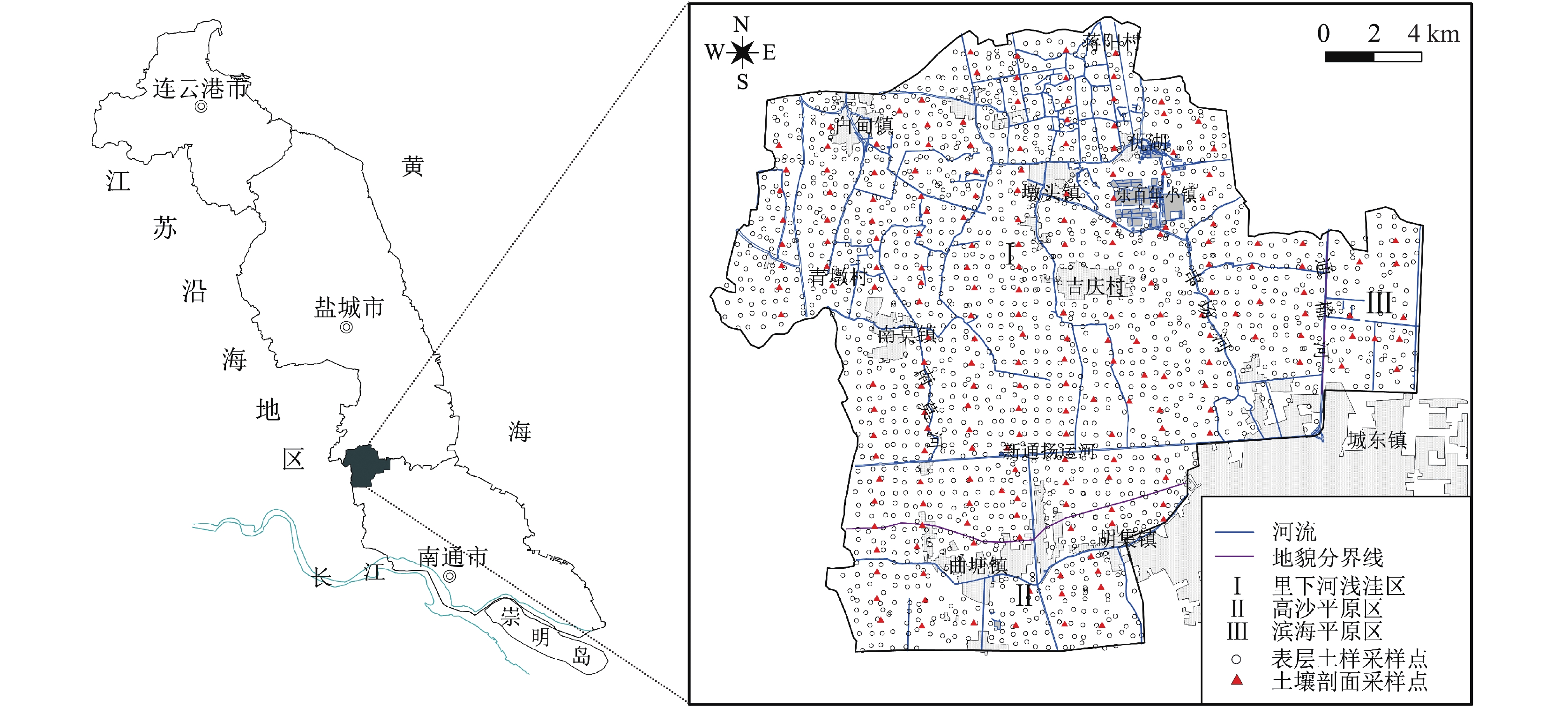
 下载:
下载:
